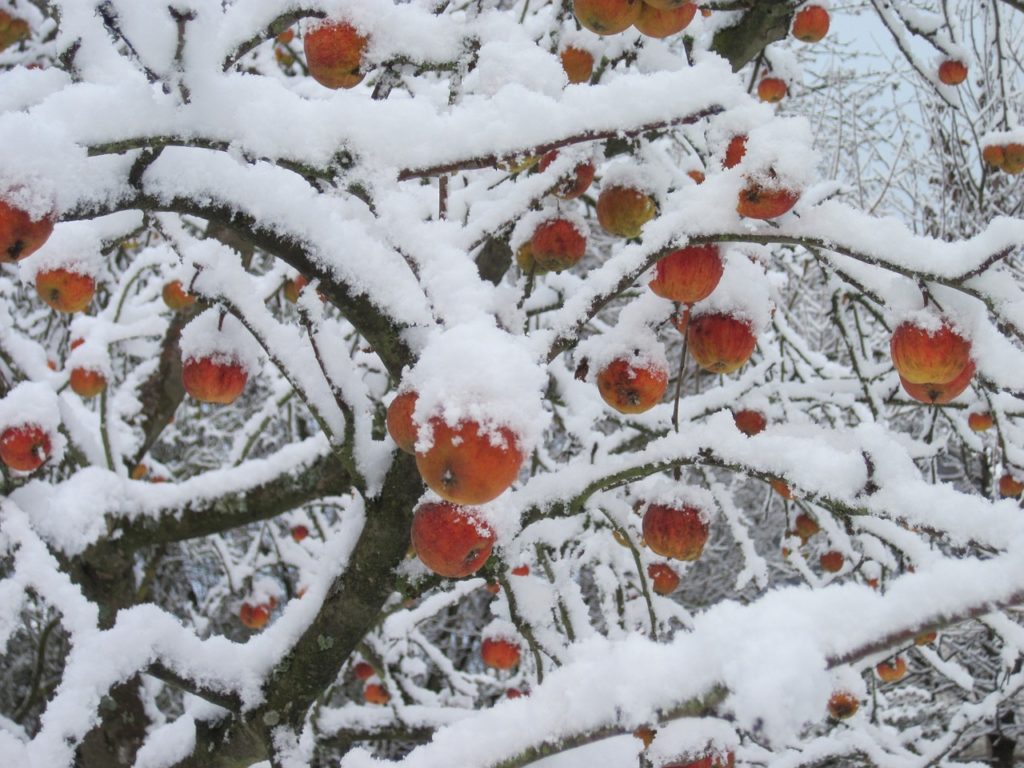Introduction
Winter is an ideal period to care for your fruit trees. Performing general maintenance on fruit trees, and ensuring that they are protected from winter damage will help them to flourish in spring. The following describes how to properly care for your fruit trees during the winter months.
Watering
Fruit trees should be watered consistently until the ground has frozen. Irrigation systems can be turned off in late fall or early winter.
Weeding
Remove weeds and wild grasses from around the base of fruit trees. This will reduce competition for nutrients between plants, and improve the quality of the soil. It will also eliminate overwintering sites for insects, and expose grubs or eggs that are present in the soil. Plant debris can be collected and utilized for composting.
Mulching
Apply a layer of organic mulch around the base of fruit trees. This will suppress weeds and wild grasses, while improving the soil quality, preserving soil moisture, and moderating the soil temperature.
Dormant Pruning
Many fruit trees are dormant during winter. The lack of foliage makes it easier to inspect the tree’s crown for structural weaknesses. Promptly remove dead, diseased, or dying branches, as well as mummified fruit. Mummified fruit can be symptomatic of fungal infection. If allowed to persist on the tree, fruiting structures will arise on the diseased fruit, and produce spores that can infect other plants the following year. To improve tree vigor, thin out the crown. Eliminate epicormic sprouts, and encroaching branches.
Inspecting Trees for Overwintering Insects
Numerous insects, including aphids, spider mites, scale, and grubs can overwinter on fruit trees. Many of these insects become active in spring, mating or feasting on host trees. When abundant, insects can decimate fruit trees. Large populations can extensively defoliate fruit trees, which often results in a reduction in tree vigor, and fruit yield.
In early winter, dormant oil can be applied to the bark of fruit trees to reduce insect populations. To ensure efficacy, perform a second application towards the end of winter. Sticky bands can be erected around trees, and on stakes to deter insects. Avoid placing sticky materials directly on the bark, as they can have phytotoxic effects.
Fruit Preservation
Examine fruit stores at least once per week for signs of decay, or pest damage. Overly ripened fruit should be consumed or discarded. Ensure that fruit stores are properly secured. Construct barriers over gaps in walls to inhibit rodents.
Protection from the Elements
Potted fruit trees should be transported into a household, greenhouse, or conservatory. Ensure that trees in pots are sufficiently drained. This will prevent the roots from freezing during extended periods of cold. Winter storms can cause snow or ice loading on fruit trees. When this occurs, gently dislodge the snow or ice accumulation by pushing the branch upwards. Avoid shaking the snow or ice off of the branch, as this can encourage it to snap, or create wounds in the bark.
Wrapping Fruit Trees
On young, soft-barked fruit trees, trunks may be wrapped with a suitable fabric to prevent sunscald, or winter burn. Sunscald is a condition in which a plant’s bark warms after exposure to the sun, and then rapidly cools at night. This causes the bark cells to rupture, inducing the formation of cracks in the trunk. Plants can be protected from sunscald with burlap strips. Each strip should wind diagonally around the trunk, and be secured with twine, or a similar material.
Preventing Salt Damage to Trees
Numerous deicing materials are used to combat snow and ice accumulation. Sodium chloride is one of the cheapest and most effective materials available. Unfortunately, it can also be detrimental to plant health. Salt damage can be minimized by using a de-icing salt composed of calcium-chloride or magnesium-chloride. Magnesium chloride is one of the best alternatives to sodium chloride. It is capable of melting ice in temperatures down to 5°F. Calcium chloride can be used when temperatures drop below 5°F. While it is not as beneficial to plants as magnesium chloride, it is still considerably less harmful than sodium chloride. Beet juice may be used as an organic solution.
Replace Wind Barriers
Assess your landscape for rotted stakes and tattered wind barriers, replacing them as necessary.


